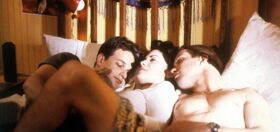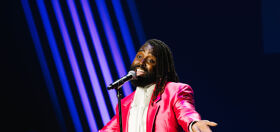
Welcome to Screen Gems, our weekend dive into queer and queer-adjacent titles of the past that deserve a watch or a re-watch.
The Stabbing: Who’s Afraid of Virginia Woolf?
Director Mike Nichols–one of the best directors in history–made one hell of a debut back in 1966 with his film adaptation of Edward Albee’s seminal play Who’s Afraid of Virginia Woolf? The movie would go on to score Oscar nominations in every acting category (to this day a major feat), winning two: Best Supporting Actress for Sandy Dennis, and Best Actress for Elizabeth Taylor.
Who’s Afraid of Virginia Woolf? follows two married couples on a night of booze-fueled antics. George and Martha (Richard Burton and Taylor), a university professor and his wife, invite another younger couple, Nick and Honey (George Segal and Dennis) over for one last drink following a faculty party. A rip-roaring fight between George and Martha ensues, with Nick and Honey first horrified by the couple’s cruelty to one another…then drawn in by it. Tensions boil even hotter when Martha mentions she and George’s 16-year-old son, and George reacts in horror. Over the course of the evening, alliances shift, secrets get exposed, and booze flows as their tragic double date builds to a tragic conclusion.
Who’s Afraid of Virginia Woolf? presents marital dysfunction at its most cruel, and alcoholism at its most explosive. Albee’s dialogue guts as deep and hard as any barb in the history of the movies…or just about anywhere else. Perhaps for that reason, all four actors give terrific performances, with real life couple (at the time, anyway) Burton and Taylor burning down the screen with every jab. Critics and audiences have often speculated that the two couples entangled in Virginia Woolf are meant to be coded same-sex couples. Edward Albee, who never hid his own homosexuality, always blasted that theory, and denied requests to stage the play with an all-male cast. For Albee, who based George and Martha on a real-life straight couple he knew, the play commented more on self-delusion in the face of disappointment and had nothing to do with homosexuality.
How about we take this to the next level?
Our newsletter is like a refreshing cocktail (or mocktail) of LGBTQ+ entertainment and pop culture, served up with a side of eye-candy.
Indeed, we theorize that the film version of Virginia Woolf endures thanks to the outstanding performances of its cast, Nichols’ innovative direction, and the text’s underlying statement that addiction and life disappointment work like poison. George and Martha desperately love one another, but a life of regret, misfortune, and defeat have fueled their addictions, causing the couple’s affections to turn to toxic rage. Nick and Honey might suffer a similar fate, as could any other couple, gay, straight or otherwise. In that regard, count us among those afraid of Virginia Woolf.
We have a feeling you will be too.
Streams on Amazon, iTunes & VUDU.
This article includes links that may result in a small affiliate share for purchased products, which helps support independent LGBTQ+ media.



















Kangol2
All of the performances in this film based on Albee’s amazing play are top notch, but Elizabeth Taylor stands apart as Martha. It is one of the greatest performances she ever gave, and a benchmark for other actors. She is mesmerizing from start to finish. Richard Burton is also excellent, but a little overshadowed by Taylor, and Segal and Dennis play their roles well too. Taylor is a tour de force as Martha, though. Last point: spend a little time in a small college town, and you’ll see George and Martha, like Nick and Honey, are anything but fictional!
lou lou de la falaise
Ain’t that the truth. I’m from a college town and call this my home town movie.
Phillip
Indeed!
That is was filmed in B/W gave it an even more stark presentation.
Brilliant idea.
Heywood Jablowme
One of my favorite movies! Btw, Edward Albee didn’t want ANY of his plays to be performed with an all-male cast – not just this one. He could get litigious about it.
quantum
Pretty sure his first play “The Zoo Story” consists of two men 🙂 Though he’s rewritten it several times under several names and now there’s a woman in the first act. 🙂
PoetDaddy
I don’t know for sure what things are like now, but I believe that for many years if you licensed “Who’s Afraid of Virginia Wolfe?”, as you would have to do if you wanted to produce it, you were forbidden under the terms of the contract to cast men in the female parts, etc. (I don’t know about the other plays.) Albee also despised the once-circulating story that Terrence McNally, his lover in the early years, had written parts of “WAOVW?” and/or that the play was based on their relationship.
Man About Town
I doubt if any such contract exists with that particular spelling.
HugoOnBroadway
In 1970, Henry Fonda and Richard Burton attempted to recruit Warren Beatty and Jon Voight for an all-male production, but Albee refused permission.[16]
Wikipedia
This is the only known pitch made (by Fonda and Burton, no less!) to mount an all-male cast. Albee made all decisions until his death; his estate retains control. As to whether or not a clause exists in any post-mortem contract, I cannot find any reference. Given that the entire play is structured upon escalating tension caused by the impending arrival of George and Martha’s son for his 16th birthday, the idea sounds ludicrous.
(One of Albee’s last over rules regarding casting, a Seattle theater company had cast a Black actor as Nick. Albee refused, adding to his long list of controversial and highly criticized decisions that made him as despised as he was lauded during his illustrious career.
Tombear
When I discussed the play with Albee in Sitges Spain he told me it’s theme was the failings of the American Revolution hence the names George and Martha.
BoomerMyles
Love the Bette Davis reference (WHAT a DUMP!) although Bette originally delivered the line in a normal unaffected delivery.
After the movie came out she was always asked to deliver it in the exaggerated Liz Taylor manner.
HugoOnBroadway
If you search YouTube about this subject, she was asked on many talk shows about the idea and said precisely what you reported. However, she would NOT do the exaggerated imitation that Taylor delivered.
And while Albee, Warner Bros., and several producers thought James Mason and Bette Davis would be perfect, DAVIS never wanted to do it. It was 1966. The character of Martha is 53 years old, Davis was 58 and said many times that after seeing Uta Hagen, Mercedes Cambridge and Elaine Strich all perform Martha during the initial Broadway run, she didn’t believe an American audience would buy the idea of young stud Nick pursuing her, ESPECIALLY so soon after ‘W.H.T. Baby Jane?’
Invader7
A great tour de force of acting by La Liz…
Brewster69
This was Liz’s best performance ever. Have watched this film many, many times and never tire of it. Finally saw it on stage in NYC with Kathleen Turner and Bill Irwin in the main roles back in 2006. It ran for only 6 months on Broadway before moving on to London’s West End. While many actors have played the main roles, Dianna Rigg & David Suchet, Patrick Stewart & Mercedes Ruehl, Mike Nichols & Elaine May, The Burtons own those roles hands down.
HugoOnBroadway
I agree.
If you love this masterpiece as much I do, you owe yourself a favor, however. Before video and live-streaming, musicals regularly made a live recording of a show to be sold as recordsets. Only a few were made of non-musicals. This was one.
Uta Hagen was regarded as one of the greatest stage actresses of the 20th century. Her BRILLIANT, Tony-winning performance as Martha is very different. Quiet where Liz was explosive and seductively demure rather than thinly veiled man-eater. Her flirting with Nick was subdued, and you don’t get the sense she would ever go through with it. Not until she declared “total war” does she make her move in savage retaliation after George chokes her. Since your listening without any film footage, the shift of her tone is menacing and chilling to hear. My parents saw the Broadway version and always said it was the most surreal evening of entertainment they experienced. It’s easy to forget how RADICAL this play was for its time. The Pulitzer Prize was first awarded to Albee, then recanted, resulting in two (three?) of the jurors resigning in protest. Albert finally did win a Pulitzer for “A Delicate Balance” and again for “Three Tall Women.” But this, IMO, is his indisputable masterpiece. That Burton lost the Oscar to Paul (Snore Bore Ponderous) Scofield is the greatest injustice of them all in Academy Award history.
Cam
It’s almost a struggle to watch because you see how deep the disfunction is. Amazing acting jobs and worth a watch.
LumpyPillows
It is incredibly dark and disquieting. I agree that the acting makes it mesmerizing.
radiooutmike
I saw this only a few years ago. This movie enshrined Liz as one of the best actors ever.
Sure, she was known as child star, a sex pot, a spectacle and an accomplished actress…but her acting in WAOVW is incredible. The first time I watched I thought she wasn’t acting, like the whole movie was a therapy session for Burton and Liz.
Cam
YES! It looked like an uncomfortable view into a drunken fight between them!
mateo
All the casting was so perfect, but Liz simply eats up every scene–and then spits it out. My favorite line, uttered by George: “Our blond-eyed, blue-haired son”.
Doug
I love this film, but it would be fascinating to watch an adaptation of it with two men.